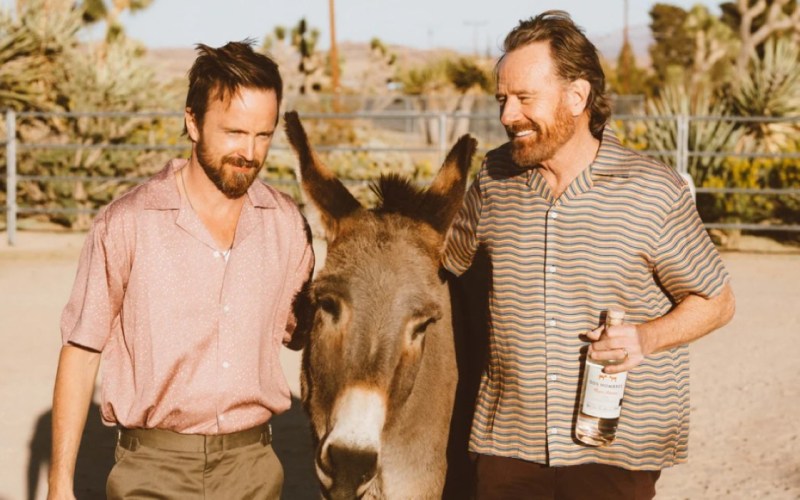
There are a lot of celebrity spirits brands. Some are more gimmick than substance. This isn’t the case with the well-known mezcal brand Dos Hombres. The brand is named Dos Hombres because it was founded by friends and actors Bryan Cranston and Aaron Paul (most well-known as Walter White and Jess Pinkman on Breaking Bad).
Dos Hombres isn’t mass-produced, overpriced swill. It’s an award-winning artisanal mezcal that’s made in small batches without implementing modern technology in the distillation process. It’s made in San Luis del Rio, Oaxaca, Mexico, by renowned Mezcalero Gregorio Velasco.
He was gracious enough to chat with us about Dos Hombres’ sustainability practices, the age its agave is harvested, and how it gets its popular smoky aromas and flavors.
Sustainability practices

Not only is Dos Hombres a complex, balanced, flavorful mezcal, but it’s also known for its sustainability practices.
“At Dos Hombres, we are conscious of the need to expand our production capacity in a smart way and have put long-term sustainability and reforestation practices in play,” says Velasco.
How they are doing it

This begins with the natural process. Dos Hombres only uses natural fertilizers. This includes agave waste from distillation.
“There is no electricity used in the process of making Mezcal. However, we have installed solar panels nearby so that as the sun begins to set, it is easier to see,” Velasco says.
Another sustainability practice is reforestation. For each Tobala plant the jimadors harvest, they plant two more to replace it. But that’s not all. The folks at Dos Hombres are also repurposing water.
“We built a cooling system to treat the water used to cool the copper stills during distillation, so this water may be repurposed to reduce the amount of water usage required for alcohol production,” says Velasco.
The brand’s sustainability practices don’t end there. It also utilizes solid waste management practices. This means that the organic residual in the copper pot stills is put into an isolated container after the distillation process is complete. The PH is then organically neutralized using wood ashes before it’s disposed of properly.
Harvesting agave at 6 years old

While Dos Hombres is known for its sustainability practices, it’s also known for its six-year-old Espadin as opposed to seven or even eight. To harvest Espadin agave, it must be at least six years old before it reaches full maturity.
“Years of maturity is just a reference to take into consideration when selecting agave for mezcal production, but it is not a general rule. In our experience, optimal maturity of espadin agave (in fact, any type of agave) depends on three main aspects: soil, altitude, and weather where the agave is grown,” says Velasco.
In San Luis del Rio, where Dos Hombres is produced, they begin harvesting agave beginning at year six and continue until the plant is eight years old. They do this because of their specific location.
“The semi-dry soil on which we grow the agave, but also the fact that we usually grow agaves on a mountain region, mean that at this altitude, we get just the perfect mix of warm and cold weather during a calendar year to harvest sweet agaves,” Velasco explains. “In warmer regions, agaves may mature a bit faster, but their taste profile and hence its quality, as well as the juice you can get out of it, will be reduced. In colder regions, agaves will take longer to reach a ripe point, and consequently, not a very efficient profile for mezcal production.”
How does Dos Hombres get its smoky flavor?

Velasco says that the smoky flavor comes from a combination of apples, mangos, and local Oaxacan fruits that are used to balance the Espadin agave.
“In our process, all is fermented in wooden barrels, which produces the discreet, smoky finish,” he says.
Unlike some mezcal brands, Dos Hombres’ earthen pits aren’t fully covered on the inside layer with stones. They leave enough space for the soil to make contact with the agave hearts (or piñas). This creates a natural filter to hold in heat and add smoky flavor.
The use of earthen pits

The use of earthen pits instead of contemporary ovens is a traditional way to craft Mezcal. Velasco believes this is the key to creating the distinctive taste mezcal fans expect when you crack open a bottle and pour a glass.
“When you become familiar with the process, the direct contact and combination of fire, soil, wind, and water, as we prepare and cook each ‘tapada,’ it becomes clear that this type of pit is also a way to keep ourselves connected with the earth, God, and nature, and to honor them,” he says.



